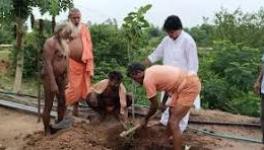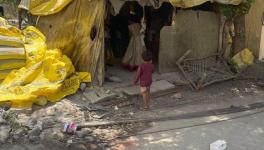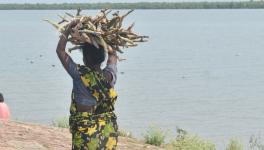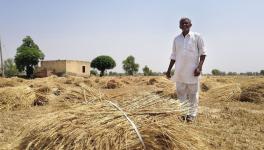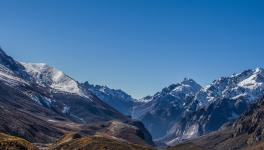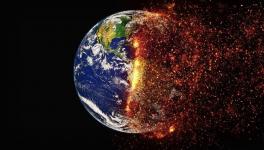‘Black Kanchenjunga’ Could Spell Danger for Water Security, Livelihoods, Claim Experts
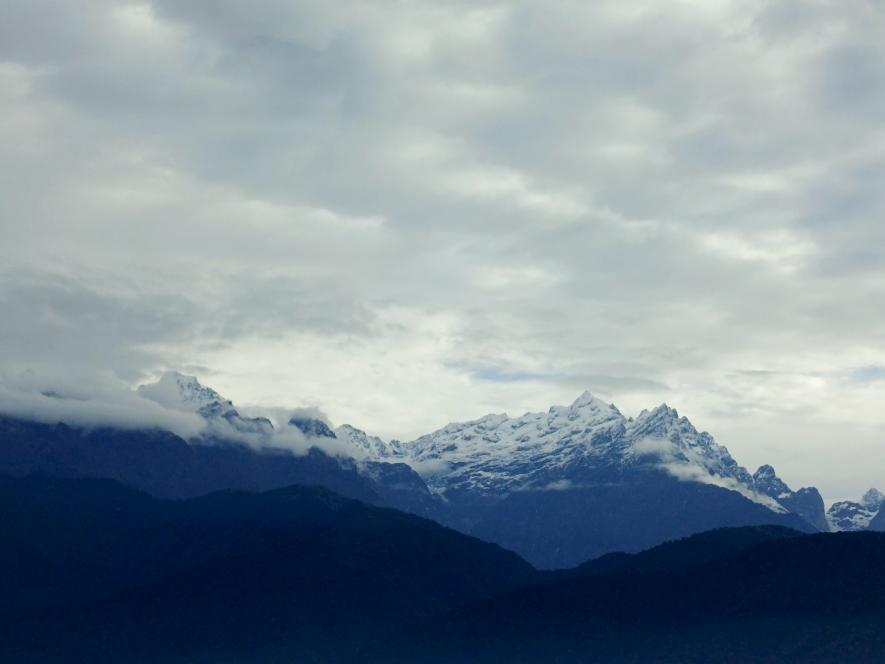
Mount Kanchenjunga from the Nepal Side.
Kolkata: A blackening of the majestic Mount Kanchenjunga has been noticed from the Sikkim side, raising grave concerns among environmentalists and people in general.
NewsClick visited Upper Pelling of Sikkim barely a fortnight ago to witness the much-talked about ‘blackening Kanchenjunga’. The famous mountain range, the third highest peak of the world and the highest peak in India, is revered in Sikkim and Nepal as a deity.
The summiting by mountaineers on Kanchenjunga from the Sikkim side is prohibited by the Sikkim government.
Several experts say that the greying or blackening of this famous mountain, from where numerous rivers generate their water source, may have deep scientific and cultural ramifications in the Indian sub-continent.
NewsClick spoke with scientific experts, including glaciologists in India, Nepal and China, to understand what was happening and whether it was a “one off” issue this year.
Manish Mehta, an expert glaciologist with the Wadia Institute of Himalayan Geology, told NewsClick: “All glaciers in the Himalayan range are retreating with different rate of retraction. In some places, they are retreating at 6 meters per annum, and in others, they are retreating to more than 20 -25m per annum. There is a variability and heterogeneity in the retreat rate. All over, the Himalayan glaciers are losing mass at the rate of 0.3m water equivalent to 1 metre water equivalent. But in the region of Karakoram, some glaciers are surging, they are expanding.”
On Mount Kanchenjunga, Mehta said: “In the eastern Himalayas, where Mt Kanchenjunga is the major range, all glaciers are retreating at a higher rate because the eastern Himalayan glaciers are fed by the Indian summer monsoon. Due to the warming temperature, rainfall is expanding and snowfall area is shrinking. That's why the glaciers on the eastern part of the Himalaya are not fed well by the Indian summer monsoon. The western part of the Himalayas are fed by westerly disturbances and hence maximum precipitation is happening there and decreasing to the east, So the eastern Himalayas do not get that much snow during the winter. These processes are a global phenomenon.”
Regarding the blackish tinge in Mt. Kanchenjunga, Mehta explained that due to warming or less precipitation of snow in the upper regions of the Himalayas, the glaciers were melting, exposing dust particles, or these dust particles were being deposited due to the wind over the glacier surface. This scattered debris or dust particles enhance the melting of the glacier. So, due to less snow precipitation, the mountain ice looks like black, he said.
Mehta cited two causes for the black tinge, one could be smoke soot or debris, or black carbon deposition over the ice surface, and the other could be due to the melting of ice making the mountain bed look black.
Basically, what happens is that if the glaciers are continuously losing mass, the crevices or the fault lines start opening up on the mountain surface, he said, making it tough to climb the mountains. “So, unless a good snowfall occurs, tourists and mountaineers should avoid climbing. All depends on the winter precipitation of snow, which is a natural phenomenon. The next season will be vital for Mt, Kanchenjunga. If the snowfall is not sufficient, then this mountain will be hazardous for years to come,” Mehta added.
Recall that it is barely a week after Everest climber mountaineer Piyali Basak, 35, had to return from the India-Nepal Army joint mountaineering summit to Mt Kanchenjunga from the Nepal side. Piyali gave an eyewitness account of the changing rock exposure in the earlier snowclad Kanchenjunga basin from the Nepal side at an event held recently.
She said: “With the black rock being exposed, the crevices stand more exposed and impossible to cross. We wore iron studded boots that we used to clamp on snow to hold the ground over the black hard rock formation that were a considerable hindrance to climbing.”
Kathmandu-based ICIMOD has been one of the leading think-tanks in the world where glaciologists have been regularly checking and predicting glacial melt pattern, and the effect of global warming on it.
NewsClick got an answer to its query from Qianggong Zhang, a senior climate change and environment specialist and Head of the Climate and Environmental Risks Unit at ICIMOD, a position he has held since February 2025. He is currently serving as Secretary-General of the Chinese National Committee for the International Association of Cryospheric Sciences and a commissioner of the China Association for Science and Technology Working Group for UN Environment Consultation.
Zhang said glacier melt had been observed to be intense and accelerating globally. This trend had been observed, confirmed, and widely acknowledged over the past decade. He said the extensive and rapid melting of glaciers was not only a consequence of global warming but should also be seen as a sensitive indicator of global warming.
“This is because glaciers are highly sensitive to climate change, and these changes may occur earlier and more visibly than sea-level rise or ecosystem responses to climate change. Additionally, I think glacier changes are among the few changes of natural landforms that can be visually observed and perceived within a human lifespan. The melting of glaciers is not just a consequence but also a warning of climate change,” he told NewsClick.
Asked how long this could continue, Zhang said: “As long as temperatures continue to rise, this trend will persist. It is important to emphasise that as revealed by models, it will be an almost linear relationship between glacier melt and temperature increase. In scientific terms, "every increases in temperatures matters." This indicates that rapid glacier retreat will continue and worsen in the foreseeable future. However, I would say that it also means that every effort to curb climate change will help reduce glacier melt, i.e., "every effort will help"
He added: “Given the current discussions on glacier retreat and its role in raising public awareness of climate change, it is significant that 2025 has been declared the International Year of Glacier Preservation (IYGP) by the United Nations, and 2025-2034 is designated as the Decade of Action for Cryospheric Sciences. This international context highlights that glacier melt and the call for climate action are gaining recognition across society. I hope the mountaineering community will further focus on glacier melt and join scientists, the public, and policymakers in efforts to prevent glacier retreat to address climate change in a more proactive and joint manner”.
Mrinmoy Chattaraj, a climate change & energy communication consultant of environmental research organisation, Climate Trends, based in Kolkata, highlighted the omnipresent danger of climate change impacting these glaciers. He said early summer heat waves were severely impacting Himalayan glaciers, potentially causing devastating consequences for downstream ecosystems and altering river water flow throughout the year. The early monsoon in 2022 also led to widespread flooding in Pakistan.
Changes in Hydrological Patterns
Persistent warming will cause glaciers to shrink, leading to increased melting in the Himalayas and more water in downstream rivers. However, the melting of Himalayan glaciers has distinct implications due to the large population dependent on the Ganga-Brahmaputra river system. While current climate change suggests increased river water due to glacial ice volume, continued melting will lead to peak water flows followed by a decline, ultimately reducing water availability, warn experts.
Projections suggest peak water levels in rivers until 2050, increasing flood risks due to higher precipitation. Beyond 2050, a shift toward decreased water availability and more frequent droughts is anticipated, requiring enhanced preparedness for floods in the near term and strategies for water scarcity in the long term.
Chattaraj said amplified warming in the Himalayas (2.2°C compared to the global 1.5°C) is causing earlier summers, accelerating ice melt and significantly altering natural river flow patterns, directly affecting water reservoirs and irrigation systems. He added that Exposed ice absorbs more sunlight, accelerating glacier melt. Glacial mass loss data from 2002 to2022 indicates approximately four times the mass loss in 2022 compared to previous records.
On the “blackening” of Mt. Kanchenjunga, Sourav Chakraborty, environmentalist and assistant general secretary of Paschimbanga Vigyan Manch (PBVM), a science- based NGO, said: “Mt. Kanchenjunga was an attraction for tourists flocking to West Bengal and Sikkim, generating considerable revenue in the economy, but this blackening of the mountain ridges of the Kanchenjunga basin makes us face the imminent danger of global warming”. He said heat wave conditions in the Indo-Gangetic plains were also affecting the precipitation of ice during the winter months in the Kanchenjunga basin.
Chakraborty said Dr Mahendra P Lama, chief economic advisor to the Sikkim government had corroborated the occurrence of ‘Black Kanchenjunga’. He had posted a video on the morning of May 30, of the mountains, terming it ‘Black Kanchenjunga’. The hydrology of rivers Teesta, Rimbet, Koshi, Rangeet river and the water there used for civilisational needs as well as about seven hydroelectric plants on Teesta river alone, are fed by Mt, Kanchenjunga, he added.
Besides the Kanchenjunga, there is the Lonak Lake where some years earlier a cloud burst had happened. “There is a chance of explosion of glacial lakes and then shrinking of rivers downstream and glacial lakes,” he added.
If the ice-melting ‘Black Kanchenjunga’ becomes a persisting phenomenon, which some scientists are predicting, then it may unleash catastrophic conditions in the entire Indo- Gangetic plains, where rivers like Teesta, Rimbet, Koshi originate. Even the question of siltation of Sundarban Indo-Gangetic-Brahmaputra delta will face a question mark, as Sundarban is yet to mature as an island geologically. It will bring desolation and destruction in the entire region,” he warned.
The most important word of caution and warning was sounded by Senior IPCC author and ISB Professor Anjal Prakash, who told Newsclick that “the accelerating melt of the Kanchenjunga glacier is a stark warning of the climate crisis gripping the Himalayas. Rising global temperatures and erratic precipitation patterns are destabilising one of Asia’s most critical water towers.”
He said this glacier “not only sustains biodiversity but also supports millions of people downstream through its rivers. Its rapid retreat is a clear signal that climate change is no longer a distant threat—it is unfolding now, threatening water security, agriculture, and livelihoods. Urgent action is needed to reduce emissions and invest in climate-resilient infrastructure across the region."
Get the latest reports & analysis with people's perspective on Protests, movements & deep analytical videos, discussions of the current affairs in your Telegram app. Subscribe to NewsClick's Telegram channel & get Real-Time updates on stories, as they get published on our website.










